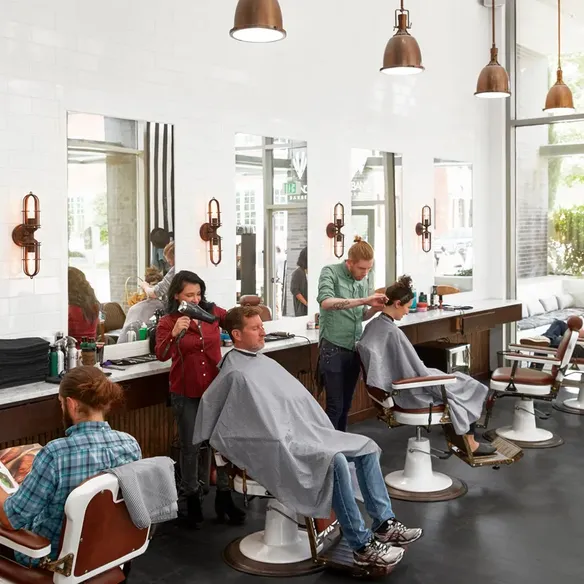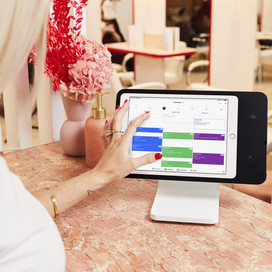Table of contents
The idea of owning your salon has been in the back of your mind for a while, and now you’re ready to make that dream into a reality. How can you start a beauty salon that is a cut above the rest?
How Much Does It Cost to Start a Salon?
Finances are always top of mind when you’re opening a beauty salon. Your goal is to be profitable as quickly as possible, but the startup costs may make you anxious.
It’s easy to shake off these initial hesitations with a little bit of planning — establish your ongoing costs, forecast your revenue potential and determine your break-even point.
First, let’s determine what your likely fixed costs will be, incurred on a regular monthly basis. Fixed costs are your salon’s expenses that don’t change with sales volume, and are typically non-negotiable (we call them fixed for a reason). Examples of these may include:
- Insurance
- Rent
- Utilities
- Equipment
On the other hand, there are variable costs. These are easier to manage, and can represent opportunities where you could potentially cut costs and save money. These are the costs of staff and materials that change with sales volume. Variable costs associated with opening a salon include:
- Labour costs
- Products and tools used by stylists
- Shipping and delivery costs to replenish products
- Advertising and marketing expenses
After you’ve determined your forecasted beauty salon expenses on a monthly basis, you should create a revenue forecast for your first year, then determine your break-even point. The break-even point is where your revenue and expenses zero each other out.
Use this information — your expenses and projected revenue — to create a budget that keeps you focused and helps you avoid overspending.
If you need an additional cash boost to get your salon up and running, there are various ways you can finance your business including traditional bank loans, asking friends and family or using Square Loans.
What Beauty Salon Equipment Do You Need?
You’ve just signed the papers and picked up the keys to your new beauty salon. One of the first things you need to do is fill your empty space with the furniture, tools and equipment you need to manage a growing list of clients.
While it’s easy to get wrapped up in buying equipment, furniture and decor, you have to remember that these things come at a price (and it’s often a high one).
To keep costs reasonable, create a basic checklist of the materials you need. Every salon needs the following:
- Salon stations that include a chair, mirror and storage space for hair and styling products
- Shampooing stations with a chair, shampoo bowl and storage space for products
- Drying stations for use during colouring services
The amount of equipment you need is determined by the size of your beauty salon, and the number of employees you plan to hire. Most beauty salons have one salon station per employee, but hair stylists with opposite working schedules may be able to share a station.
A small reception area is also necessary for most salons as a place to greet customers and manage appointments. Many beauty salons don’t worry about staffing their front desk with a permanent employee, especially in their early days. You should set up an iPad point-of-sale stand, positioned to accept payments from customers after their session is complete. You can also display promotional offers for your business at the front desk.
Pro tip: Most of the beauty salon equipment and furniture can be bought at wholesale prices through your materials provider. Many brands — for example, the shampoo you use — may also offer promotional equipment or materials that you can use in your early days, to help save money during your startup phase.
How to Hire the Beauty Salon Dream Team
Hiring the right staff for your beauty salon is essential; the quality of their work can be make-or-break for your new business, particularly as you’re establishing your credentials.
Before you start the interview process, create a list of the qualities you’re looking for in an ideal candidate. Compiling some interview questions that address these needs also helps you stay focused when you meet a candidate face to face. Here are some things to consider:
- Skill set: The candidate’s skill set and capacity to learn are both important to think about when interviewing. Think about how many years of experience you want your stylists to have. Do you want each stylist to have proficiency in colouring? Or do you want a multi-skilled team member who can do both cuts and waxing?
- Attitude: A candidate’s attitude and work ethic determines their dependability, and ability to work with others, and it will help you get a sense of how they interact with customers.
- Personality: A candidate’s personality should match the company culture you want to infuse into the salon. Whether you are aiming to be an upscale boutique or a family-focused shop, you want your company culture to be a natural fit for all your team members. Think about how you want to define your company culture and the traits that each employee should have.
When you’re ready to make a hire, make sure you confirm the candidates’ experience with their professional references, confirm their eligibility to work, obtain the correct workers’ compensation insurance, and set up records for withholding PAYG taxes. To ensure you’ve covered your specific needs, seek advice from your bookkeeper or accountant.
Once you’ve hired and onboarded your employees, you might feel like your job is done. Not so fast. The beauty salon industry is competitive, and it’s not unfamiliar to see stylists jumping between salons.
To minimise employee turnover at your beauty salon, you have to provide them with reasons to stay. Here are four ways to manage your employees more effectively:
- Build strong relationships with your direct reports and encourage team bonding activities outside of working hours.
- Outline a career path for employees and give your hair stylists an opportunity to advance or progress.
- Promote from within before you hire outside your salon; this encourages stylists to stay as they can see internal opportunities.
- Offer competitive compensation compared to salons in the area.
Taking Payments at Your Beauty Salon
Once you have stocked your salon with supplies and hired some amazing stylists, it’s almost time to open your doors. But before you do, you want to make sure you can accept payments from your customers and manage your transaction data.
Let’s start with accepting payments. Look for a payments processor with clear pricing and no hidden fees. Your payments system should allow you to accept every form of payment quickly and securely, including credit cards, debit cards and mobile wallets (such as Apple Pay, Android Pay and Samsung Pay).
When you are assessing various payments processors, be sure to ask the following questions:
- How long does it take to get set up?
You should look for a payments processing system that is fast and simple to set up. Any delays on the provider’s end could push back your opening time.
- How much is it going to cost me?
Pricing varies between payment providers. Traditional providers may have a recurring monthly fee, terminal rental fee as well as a variable merchant services fee (the fee charged per transaction) which will be based upon the type of card the customer pays with. Other providers may offer clearer, transaction-based pricing with no monthly fees. Be sure to understand exactly what the cost will be to your beauty salon.
- How quickly are deposits paid to my bank account?
You want to get paid for your services quickly and not endure lagging processing time. You should expect to receive deposits as fast as the next day in most scenarios.
- How long will I be locked into a contract, and are there any break-contract fees?
Some payments systems may lock you into a 12- or 24-month contract, with hefty fees if you decide to leave early. Newer options are a lot more flexible, with affordable, pay-as-you-go or per-transaction pricing models. This gives you flexibility to grow and scale, without the fear of being encumbered by a long-term agreement.
- Does it accept all major cards?
Make sure your EFTPOS machine is able to accept all major cards — in Australia the most common card types are eftpos, Visa, Mastercard, American Express and JCB.
But don’t think of your payments processor in a silo. Ideally, you want your payments processor to be integrated with a point of sale that can help you run your entire business. A beauty salon POS system can integrate your payments system with other salon operations and apps — for things like appointment scheduling, employee management tools and bookkeeping software you can easily integrate with — that make your day-to-day management more efficient, and give you more time to spend growing your beauty salon.
You should also look for a beauty salon POS that enables you to create a customer directory right at the countertop — enabling you to keep a record of customer details, preferences and a detailed transaction history, which can all be accessed by staff to enable a smoother checkout.
Additionally, you can access sales reports, customise discounts and manage inventory in real time with the beauty salon POS system. You can even use a point-of-sale system to get direct feedback from customers through a private feedback channel.
With Square POS, you can also easily accept card payments, gain powerful sales insights and manage your team efficiently in an all-in-one solution. Learn more about Square POS.
All of these integrations can give you a more holistic view of your beauty salon and help you manage your business easily and with efficiency.
Why Do Beauty Salons Fail?
Many beauty salon owners do substantial research, create a robust financial plan and take all the right steps when starting their business. But staying afloat in the health and beauty industry can be tough.
Here are four reasons why some beauty salons fail in their startup phase:
- Inadequate cash reserves. You need healthy cash flow to manage unexpected costs and fees that you may incur when you are opening a salon.
- Lack of industry experience. Without relevant experience in the industry, you can struggle with day-to-day operations and forecasting for future growth. Many top-performing salon owners have been in the industry for many years. You’ll get there over time, but remember to learn as much as you can from those who are in the business already, and take those lessons to heart when you’re planning.
- Failure to keep up with trends. Salon trends change frequently, and being a stickler for the old way of doing things can have a material impact on your business. Promote continued education for your staff and encourage them to learn new skills and expand their services. This will also empower them to upsell more beauty services to clients, meaning more sales.
- Competition. A heavily saturated industry means that competition is a top struggle for many beauty salon owners. Owning a salon is a lucrative business that attracts a lot of savvy entrepreneurs, so it’s important to constantly assess your local competition and aim to stay competitive with prices, services and overall customer service.
A Beauty Salon Success Story
Knowing the risks sets you up for greater success. It’s important to acknowledge and plan for risk factors. But instead of harping on the hurdles that you may come across along the way, think about the type of success you’d like to achieve.
Take some advice from Chelsea Bagan, owner of Trophy Wife in Richmond, Victoria. Chelsea left a corporate career to follow her dream and open her own beauty salon, and she hasn’t looked back. Trophy Wife was built to give likeminded creative beauty professionals a local salon where they could service their clientele. Little did Chelsea know that within six years her business would become one of the most recognised beauty salons in Melbourne.
“We like to run Trophy Wife less like a salon, and more like hanging out with friends,” says Chelsea. “I think getting your nails done should be more of a personal experience, rather than a sterile service where you are churned in and out as quickly as possible. We like to get to know our clients and their stories, and we love finding out about their ‘behind-the-scenes’ reasons when it comes to nail styling choices.”
Personalising the customer experience has been crucial to the success of Trophy Wife, but as its reputation has expanded, so has the number of employees working there. “We have recently expanded to offer more beauty services, which is really exciting for us,” says Chelsea. “We’re now a one-stop-shop for hair, nails, lashes, brows, facials and more.”
More services and employees have prompted Chelsea to invest in her point-of-sale system, utilising Square for everything from card payments to sales reporting. “We use Square for point of sale and payments. It’s easy to use and the money gets put into our bank account fast, which is important for a small business. Cash flow is the most important thing to learn how to manage quickly in any small business.”
Pairing her point of sale with app integrations has also streamlined Chelsea’s administration. “There’s an app for everything these days and it’s a huge time-saver,” she says. “We also use the staff rostering system Deputy, which keeps everyone in the loop around shift availability.”
With a solid foothold in Melbourne, Chelsea and Trophy Wife team are now looking to the future, while keeping an eye on home base: “We’re focused on growing our reputation in Melbourne but we’re also working towards being able to open a salon in every state across Australia,” she says.
![]()











